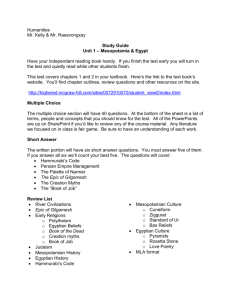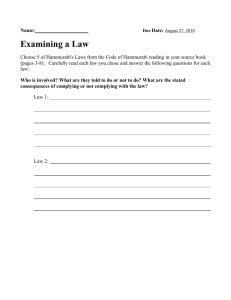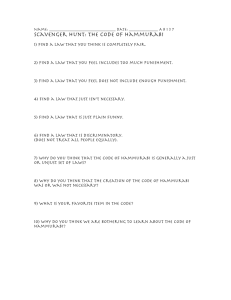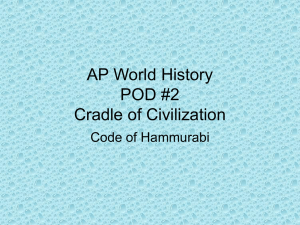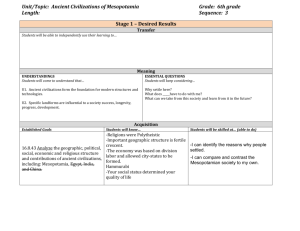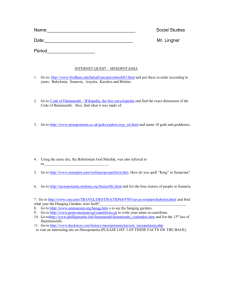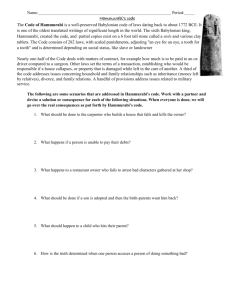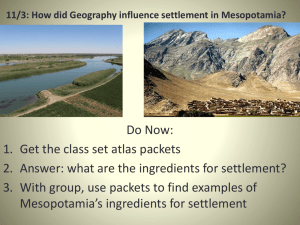Mesopotamian Study Guide
advertisement
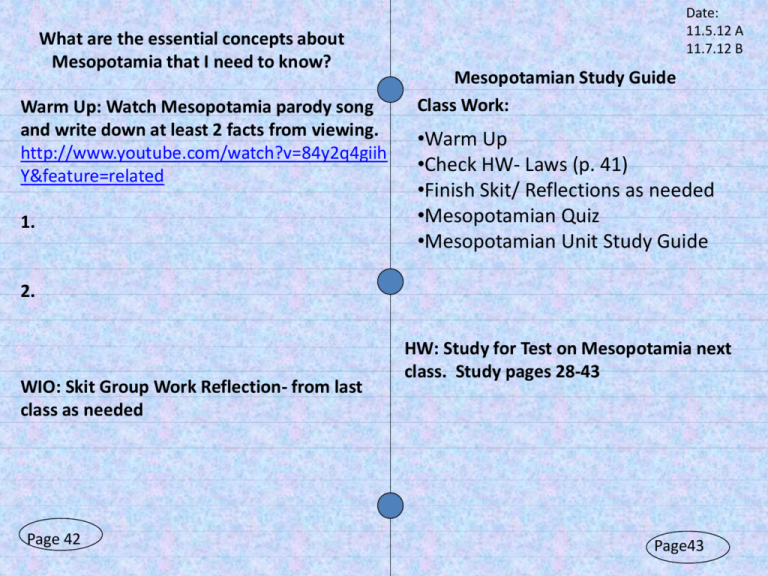
What are the essential concepts about Mesopotamia that I need to know? Warm Up: Watch Mesopotamia parody song and write down at least 2 facts from viewing. http://www.youtube.com/watch?v=84y2q4giih Y&feature=related 1. Date: 11.5.12 A 11.7.12 B Mesopotamian Study Guide Class Work: •Warm Up •Check HW- Laws (p. 41) •Finish Skit/ Reflections as needed •Mesopotamian Quiz •Mesopotamian Unit Study Guide 2. WIO: Skit Group Work Reflection- from last class as needed Page 42 HW: Study for Test on Mesopotamia next class. Study pages 28-43 Page43 Laws- HW • Pair-Share Laws • Be prepared to present at least 1 per group!! Finish Skits/Reflections-p.40 • 1. Which of Hammurabi's laws was the most unfair? • *2. Which of Hammurabi's laws was the most reasonable? Why? • *3. What group or class of people were the most favored and protected by the code of laws? Explain. • 4. What group or class of people were least protected and least favored under the code of Hammurabi? • 5. How would you feel if you lived under the code of laws in Hammurabi's Babylon? • *6. Slavery was very common in the ancient world. Why do you think it existed? Why have most societies and cultures eliminated slavery today? • 7. Was reenacting the laws a valuable use of class time? Why or why not? • *8. Did acting out the various situations help you to understand anything better? Worse? Give examples. Mesopotamian Life Quiz • You have 20 minutes. • You do NOT use all the words in the word bank • Flip it over when you are finished. Grading the Quiz •Pass to another classmate to grade. •Use a different color or type of writing utensil than what is used on quiz. •Take 5 points off for each one that is incorrect. •Just put an X on ones that are wrong. •DO NOT write a score on the top of the paper Quiz Answers-Take off 5 for each • • • • • • • • • • 1. Trader 2. donkeys or on a raft 3. trade center 4. Hammurabi 5. Hammurabi’s Code 6. Babylonian 7. eye for an eye 8. Gilgamesh 9) True 10) False Mesopotamian Study Guide • You will work with a partner to complete the study guide. Use your notebook pages 27-42 to compete. • Make sure the study guide is taped on page 42. Study Guide Answer Key • 1) Mesopotamia- “land between the rivers.” 1st civilization, located in current day Iraq • 2) Fertile Crescent- area of fertile land within the middle east between Mediterranean Sea and Persian Gulf • 3) Hammurabi’s Code- 1st written laws and punishments • 4) Irrigation- method to get water to crops. Use of channels and levees • 5) Job Specialization- people will focus on one job to help the society Study Guide Answer Key con’t… • 6) Agriculture- innovation in farming crops which led to a surplus in food • 7) Ziggurat- Mesopotamian temple • 8) Cuneiform- 1st written language. Wedge-shaped writing • 9) Civilization- a group of people working and living together • 10) Social class- levels within society based on job/wealth status. Nobles/Priests/Kings> Merchants and Farmers> Slaves Study Guide Answer Key con’t… • 11) Trade Center- central location where tradesmen will gather to trade goods • 12) Polytheistic- religion which worships many gods. Monotheistic- religion which worships one god. • 13) Innovation- a new development, could be an invention or an idea, which improves an aspect of society • 14) Cradle of Civilization- nickname for Mesopotamia because it is the beginning of civilization Study Guide Answer Key con’t… • 15) Rivers! Early civilizations needed water and fertile land in order to survive. • 16) Lack of food, water, shelter, and natural resources or a threat from another civilization were constant problems the early civilizations faced. • 17) Cuneiform, the wheel, ramps, number systems, etc. • 18) The Epic of Gilgamesh taught the people of Sumer about various gods and how one should lead a life where good is done. • 19) Shows values and treatments based on social class and gender. Government has responsibility to control the people. Homework • STUDY FOR YOUR TEST THURSDAY/FRIDAY • Pages 27-42 in notebook
